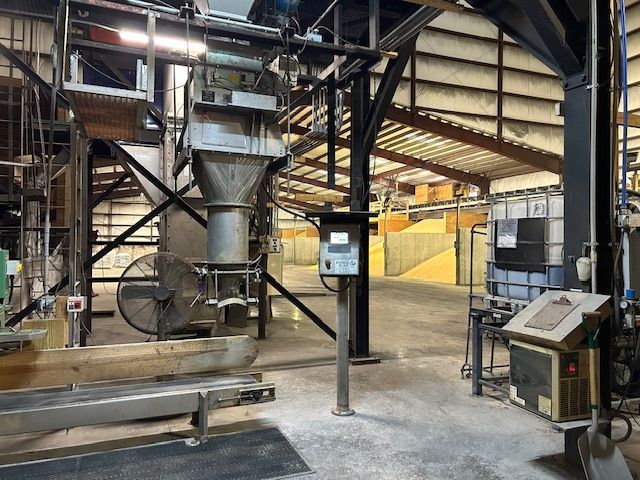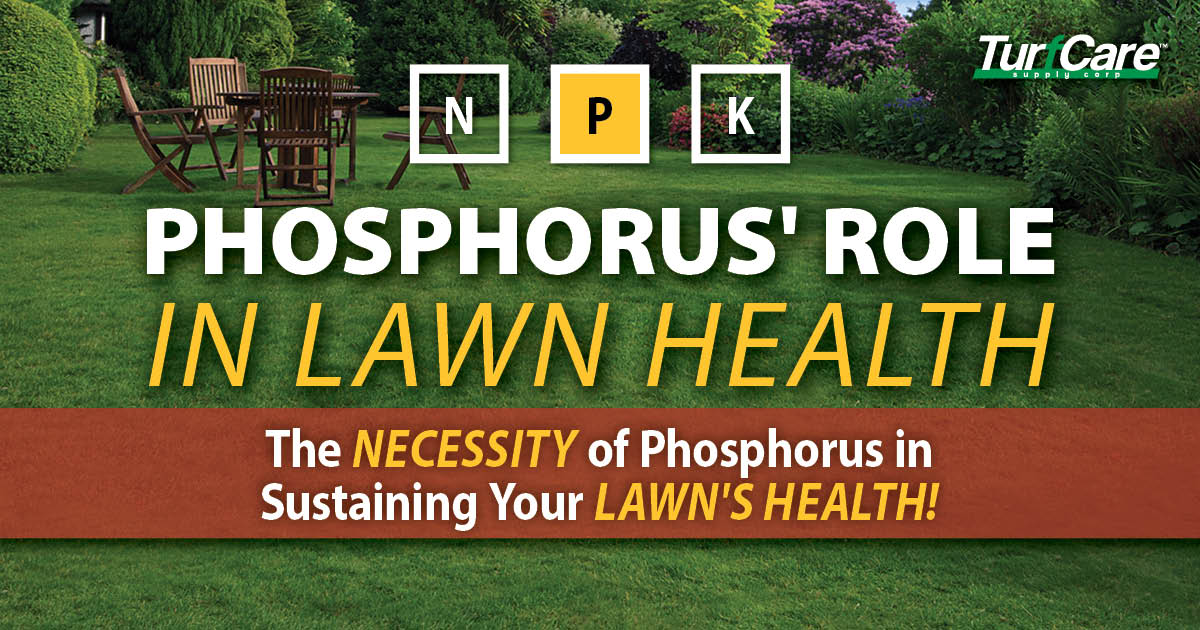THE NECESSITY OF PHOSPHORUS IN SUSTAINING YOUR LAWN'S HEALTH!
Healthy lawns depend on a well-balanced fertilizer program that provides the essential elements it needs like: Nitrogen (N), Phosphorus (P) and Potassium (K). A healthy lawn is necessary to successfully ward off weeds, insects and disease. Although most fertilizers contain a variety of elements, in this article we are going to focus on just phosphorus (P)! Phosphorus is a macronutrient (just like nitrogen and potassium), and when needed, is required in larger quantities because it is normally bio-unavailable in the soil. Phosphorus, which is found in every living plant cell is vital in seed germination, establishing root growth and plant development. Without phosphorus, grass would appear stunted, especially in early stages of growth. Discover why phosphorus’ role in turf and soil is important to the overall health of a lawn:
WHAT IS PHOSPHORUS?
Phosphorus or “P” is a primary plant nutrient that is involved in the metabolic processes responsible for transferring energy throughout the plant. It is crucial to introduce phosphorus when first establishing turf grass and remains important as the grass continues to grow. The presences of phosphorus in soil helps turf grow lush and thick because it promotes strong root growth. An abundance of phosphorus allows plants to grow more efficiently.
PHOSPHORUS BENEFITS YOUR LAWN BY:
- Enhancing Plant Energy Reactions; phosphorus plays a vital role in the energy transfer of plants. Phosphorus is responsible for the source of energy that drives many chemical reactions within plants: ADP (adenosine diphosphate) and ATP (Adenosine triphosphate), setting the stage for many chemical processes essential to plant health to occur.
- Assisting in the Transfer of Genetic Material from One Generation to the Next; this primary nutrient is a vital component to the building blocks of DNA. The building blocks of genes and chromosomes that are transferred from one generation to the next, essentially provide the “blueprint” for plant growth and development.
- Optimizing the Transfer of Sugars and Starches within Plants; the most important chemical reaction for plants is photosynthesis. Photosynthesis is the reaction that utilizes the sunlight’s energy to convert carbon dioxide and water, in the presence of chlorophyll, into simple sugars and future energy sources. The sugars are used as future building blocks for the cell structure and storage components. Energy is then stored in the form of Adenosine Triphosphate (ATP), rendering it available as an energy source for other reactions in the plant.
HOW TO TELL IF A LAWN HAS A PHOSPHORUS DEFICIENCY
Phosphorus deficiencies can be difficult to identify because they often mimic other nutrient deficiencies or pest invasions. It’s advised to do a soil test to determine deficiencies prior to applying phosphorus. For example, low “P” in soil can take on the signs of nitrogen deficiency in new growth, appearing yellow and weak. An inadequate amounts of phosphorus in the soil can also represent itself as reduced leaf expansion and surface area, in addition to limited numbers of blades. Both shoot and root growth could also look stunted, leading to less root mass to uptake nutrients and water. Phosphorus deficiencies can result as a buildup of carbohydrates through photosynthesis, resulting in foliar deficiency (this can be seen as an abnormal dark green leaf color). Sugars can accumulate as well, causing anthocyanin pigments (a reddish–purple color) to appear.
NOTE: Carbohydrate buildup and anthocyanin pigments will usually occur at extremely low phosphorus levels in soil. Be careful to check for insect damage as well; pest invasion damage can resemble the look of anthocyanin pigments.
PHOSPHORUS REGULATIONS ON TURF – SOIL TESTING IS KEY FOR APPLYING THIS NUTRIENT
Phosphorus is tightly regulated because this nutrient has been known to cause the degradation of surface water quality. Fortunately, most soil already contains enough phosphorus to sustain root development and growth of established turf. Regulations have been established to allow lawns to have the nutrients they need, when needed (example: early turf development), while keeping the waterways clean. Each state has different phosphorus regulations, so fertilizers should be selected carefully based on turf’s needs and state regulations. Talk with your country extension office for more information about phosphorus regulations in your state. Also, conduct a soil test to determine if phosphorus is lacking within you soil and at what rates it should be applied. If you’re starting a new lawn, plants will benefit from a starter fertilizer that contains phosphorus to help develop healthy root systems, stimulate growth, and assist with energy reactions throughout the plant.
BEST TIMES TO APPLY PHOSPHORUS
- Establishing new turf (Starter fertilizer).
- Curing a lack of phosphorus necessary for plant root development and growth (determined by a soil test).
- Repairing turf – reseeding or sodding damaged areas of the lawn (Starter fertilizer applied to those areas).
- PROtip: Overall, the best method to make phosphorus in soil available for plant uptake is by adopting a regular lawn care routine. This includes proper fertilization, proper soil amendments management, proper mowing and watering, as well as proper aeration and thatch management.
Phosphorus is associated with healthy root development and growth, but plants use it for many other processes. Phosphorus is vital, especially when starting a new lawn, repairing a lawn or curing a lack of phosphorus in the soil as well as sustaining the health of established turf and plants all year round.
For professional fertilizers, humic and AMP-XC™ enriched products available, please visit TurfCare’s online Product Catalog.
For green industry professionals or others interested in ordering Turfcare products, please contact our Customer Service
to find a distributor near you.
References:
https://www.gardeningknowhow.com/garden-how-to/soil-fertilizers/phosphorus-plant-growth.htm
https://www.bhg.com/gardening/yard/garden-care/what-do-nitrogen-phosphorus-and-potassium-do/
https://www.extension.purdue.edu/extmedia/AY/AY-334-W.pdf
https://www.extension.umn.edu/garden/yard-garden/lawns/fertilizing-lawns/
http://homeguides.sfgate.com/phosphates-make-grass-grow-faster-efficiently-37265.html
https://www.ipni.net/ppiweb/bcrops.nsf/$webindex/ECBABED567ABDCDD852568EF0063C9F4/$file/99-1p06.pdf
https://passel.unl.edu/pages/informationmodule.php?idinformationmodule=1130447043&topicorder=2
https://www.cga.ct.gov/2012/rpt/2012-R-0076.htm
Turf Care Supply - TurfReport Blog

Turf Care Supply, LLC, a portfolio company of Platte River Equity, has officially acquired Beaty Fertilizer, the industry respected Tennessee-based manufacturer and blender of custom granular and liquid fertilizers, as well as combination products. This strategic move expands Turf Care’s manufacturing footprint, adds new product capabilities, and enhances overall production capacity. “The partnership with Beaty Fertilizer marks a major milestone in our journey and an important step forward in our mission to grow, innovate and lead in our industry,” said Mark Mangan, President of Turf Care. “This acquisition is more than just expansion; it’s a powerful opportunity to strengthen our product offerings, broaden our market reach and provide greater value to our customers. By welcoming Beaty into the Turf Care family, we are reinforcing our commitment to excellence and positioning ourselves for an even brighter future.” “We are excited about this next step in the Beaty Fertilizer story. For almost 50 years, our family and our employees have worked hard to serve customers and communities with pride and heart,” said John Beaty, President of Beaty. “Now, we are embracing an opportunity for growth with Turf Care. With our combined know-how and resources, we’ll keep building on what we’ve worked so hard to create and bring even more value to our customers, employees and partners. We truly believe this partnership will keep the Beaty legacy going strong while opening up new doors for growth and innovation.” Tarun Kanthety, Vice President at Platte River, added, “We believe the acquisition of Beaty Fertilizer represents a strategic step in expanding Turf Care’s footprint and product breadth... as it scales and enhances its value proposition to customers.”

Root out Grubs, Before they Attack Yours! White grubs, the immature stage of several scarab beetles—including Japanese beetles, masked chafers, May and June beetles, and green June beetles—are a major threat to turfgrass across the Southeast. These beetles follow a complete metamorphosis (egg, grub, pupa, adult), with most species completing their cycle in one year. Eggs are laid in early summer, grubs hatch within two weeks, and begin feeding on turfgrass roots through the late summer and fall. May and June beetles differ slightly, with a two- to three-year life cycle and prolonged feeding as third-instar grubs. Grubs damage turf by severing roots, causing grass to yellow, wilt, or lift easily from the soil. Feeding is typically concentrated in patches and worsens during hot, dry weather. Wildlife digging for grubs can create further turf destruction. Healthy turf may tolerate 5–10 grubs per square foot, but damage becomes evident as populations rise or turf is under stress. Early detection and timing are essential. Scouting begins in late June, shortly after adult beetle activity peaks. Monitoring plants favored by beetles can signal egg-laying is underway. Treatment is most effective when small grubs are active—typically from mid-July through early August. For professional turfgrass managers, insecticides containing imidacloprid (Merit®), chlorantraniliprole (Acelepryn®), or trichlorfon (Dylox®) are the most effective tools. The primary months of preventative application of Acelepryn® is from April to end of May and Merit® from April into July - targeting grubs before they hatch. Curative treatments with Dylox® or similar products are applied July through the fall, when young grubs are feeding and most vulnerable. Always follow label directions for optimal application and safety. Timing may vary slightly by regional seasonal needs. Turf Care Supply has a variety of professional TCS Growstar insecticide fertilizers available to protect your turf and prevent grub damage, before it starts. Click on the button below to view products, contact your sales rep for addition TC Growstar products available.

Platte River Equity Portfolio Company Turf Care Supply, LLC Acquires Agri-Nutrients, Inc. Brunswick, OH , October 9, 2024 – Platte River Equity (“Platte River”) portfolio company Turf Care Supply, LLC (“Turf Care”) is pleased to announce its acquisition of Agri-Nutrients, Inc. (“Agri-Nutrients”), a manufacturer and blender of custom granular fertilizers for the turf & ornamental (“T&O”) industry. This strategic acquisition provides Turf Care with an established presence in the south-central United States, an enhanced product portfolio and additional manufacturing capacity. “This acquisition represents much more than a business transaction; it is a strategic step forward in expanding our reach and enhancing our customers’ growth. By bringing Agri-Nutrients into the Turf Care family, we are broadening our product portfolio, expanding our market presence and further positioning ourselves as a leader in providing innovative solutions for our customers,” said Mark Mangan, President of Turf Care. “We are excited about joining the Turf Care team,” said Jim Montgomery, President of Agri-Nutrients. “At Agri-Nutrients, our core values center around customer service and product innovation, and we are confident that this combination will allow us to better serve the needs of our customers.” “Platte River welcomes the Agri-Nutrients team to Turf Care. This transaction underscores our long-term commitment to fostering growth through both organic and inorganic initiatives across the Turf Care platform,” said Tarun Kanthety, Vice President of Platte River. “The partnership with Agri-Nutrients strengthens Turf Care’s value-added offering, creating additional growth opportunities across the combined customer base.” B&A Corporate Advisors served as the exclusive financial advisor to Agri-Nutrients. About Agri-Nutrients Founded in 1992 and based in Catoosa, OK, Agri-Nutrients is a manufacturer and blender of custom granular fertilizers for the T&O industry, predominantly selling into the lawn care, sports turf and golf course end markets. About Turf Care Supply Established in 1974, Turf Care Supply is one of the largest formulators and blenders of urea products to the T&O market. Turf Care has a comprehensive product portfolio of fertilizers, combination products (herbicide/insecticide), soil amendments and enhanced efficiency fertilizer ingredients. Turf Care's products are sold to distributors and blenders serving the commercial, residential and golf end markets. Turf Care operates four manufacturing facilities strategically located throughout the eastern U.S. About Platte River Equity Founded in 2006 and based in Denver, CO, Platte River Equity is a private equity firm focused on investments in established lower middle market operating companies within targeted industrial sectors where it has substantial operating and investing experience. Platte River utilizes prudent capital structures in order to invest in future growth opportunities and withstand changing economic environments. The firm also provides significant ongoing support to its portfolio companies through dedicated resources across functional areas. The firm has raised funds with committed capital in excess of $1.6 billion and is currently investing out of its fifth fund. The Platte River team is the largest collective investor across its funds, deeply aligning the firm with its investors and portfolio company management teams.

